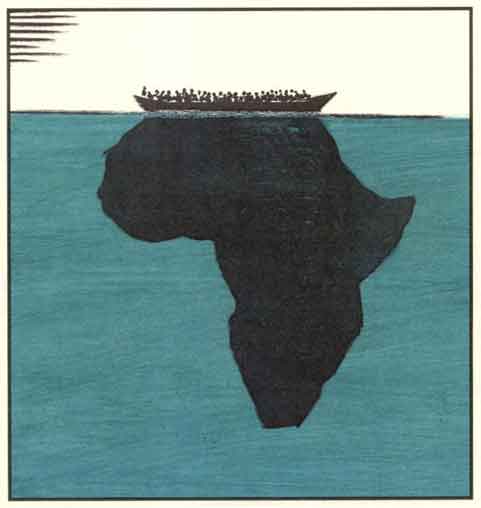 Stephen Fox, VTT Technical Research Centre of Finland
Stephen Fox, VTT Technical Research Centre of Finland
Reframing mass migration
Thus far, responses to mass migrations of 2015 have included maritime rescues, humanitarian goodwill, border reinforcements, and migrant allocation disputes. Meanwhile, socio-technical strategies for reciprocal prosperity growth between regions of emigration and regions of immigration have not been proposed. Rather, establishing prosperity in regions of emigration can seem to be a hopeless goal; and establishing reciprocal prosperity growth may not even be imagined as a possibility. This can be because of preconceptions that prosperity is always best facilitated by centralized provision of resources to meet mass demand in stable conditions. For example, central banks providing fiat currencies; central governments providing school curricula; central energy generation providing electricity; and so on. This centralized prosperity has prerequisites that many regions of emigration do not have, including capital wealth and decades of stability.
However, preconceptions that prosperity is always best facilitated by centralization are out-of-date. This is because there are an ever increasing number of socio-technical innovations that enable prosperous decentralization. These include digital alternatives to centralized control of fiat currencies; mobile devices bringing online and offline education; mini-grids generating energy from solar, wind, etc. In this article, four inter-related socio-technical strategies are described for establishing reciprocal prosperity growth between regions of emigration and regions of immigration. They are as follows: decentralized prosperity infrastructure; distributed advanced prosumption; reciprocal prosperity zones; and open access to latent resources. All of these strategies involve increased application of socio-technical systems that already exist, and that can be made more cost-effective through wider application.
Currently, addressing mass migration is framed by much of the media as a struggle to contain an escalating security crisis. By contrast, the four strategies described in this article reframe addressing mass migration as an opportunity for reciprocal prosperity growth.
Decentralize prosperity infrastructure
Centralization in regions of emigration leaves the majority areas without infrastructure for clean water, reliable energy, adequate sanitation, rapid communication, and other requirements for prosperity. This pattern of polarization, between those who have infrastructure and those who do not have infrastructure, is being reinforced by development of smart cities and mega infrastructure projects to serve them.
In the short-term, smart cities can provide havens for those few who have sufficient financial wealth to be able to move out of overcrowded old cities. In the medium-term, smart cities can function as islands of infrastructure, which are surrounded by informal settlements without any infrastructure and old cities with malfunctioning infrastructure. However, in the longer term, the concentration of infrastructure at a few locations can lead to rural exodus that overspills conurbations and becomes migrant tides. At the same time, mega infrastructure projects to serve centralized populations, such as huge dams, force population displacements that can also lead to mass migrations. Then in the future, rural depopulation can leave countries vulnerable to cross border incursions, which can also contribute to mass migrations.
By contrast, decentralized infrastructure provision for soil, water, energy, and food can reduce environmental pressures that push people into migration. Also, decentralized infrastructure provision for sanitation, communication, and transportation can reduce economic pressure for migration by facilitating profitable regional commerce. In addition, decentralized infrastructure provision for housing, healthcare, and education can reduce social pressures for migration by balancing local population growth with local economic growth. Together, the reduction of environmental, economic, and social pressures can reduce the risk of violent conflicts, which can escalate into wars that precipitate mass migrations.
Advanced prosumption of decentralized infrastructures
Decentralized infrastructures need to be multi-adaptive in order to function well in the face of significant unpredictable challenges brought to populations by, for example, climate change and market forces. Multi-adaptive infrastructures can encompass ecological, built, and electromechanical elements. Ecological elements can include green walls, shelter belts, windbreaks, etc.; built elements can encompass drainage, roadways, housing, etc.; electromechanical elements can include turbines, motors, pumps, etc. To maximize engagement and employment, decentralized infrastructures, and any subsequent adaptations of their multiple elements, can be achieved through production involving local populations.

The proposition that migrants can return to regions of emigration to undertake such work may seem unrealistic to those who see mass migrations as dehumanized swarms, rather than as many individuals with diverse educations and skills. It may also seem unrealistic to those who are not familiar with established industrial engineering techniques and recent socio-technical innovations.
Established industrial engineering techniques, such as Design for Assembly, Task Design, and Six Sigma, have long been successful in enabling world class production to be set-up quickly with workforces that do not have existing relevant production skills. In addition, digitally-driven manufacturing innovations enable rapid conversion of design information into physical goods. An important advance is that complex components can be made accurately and quickly by additive manufacturing machines, and/or by multi-head computer-numerically controlled subtractive manufacturing machines, via direct transfer of digital data. Such machines require some maintenance, but this is no more challenging than the electrical, hydraulic, and mechanical maintenance that is already carried out by local people to keep trucks moving in challenging conditions across Africa and Asia. Moreover, there are new online communities that share experiences and expertise about digital-driven production throughout ideation, design, manufacture, assembly, installation, and recycling. Infrastructure elements can be made adaptive through application of established principles for product architecture, product modularization, and Design for Disassembly. Application of these principles enable infrastructure to be easily put together, put apart, and put to new locations.
When people make what they use, they are involved in prosumption. This is part of everyday life in subsistence economies. However, subsistence prosumption is inefficient. By contrast, advanced prosumption that involves industrial engineering techniques and digitally-driven technologies is efficient and can be scaled up. (Continue Reading >>)











thanks for sharing this interesting article.. a proactive approach to the migration fact. I agree that decentralization with supported socia-technical strategies and solutions may turn this fact to an opportunity for both sides..
thanks again